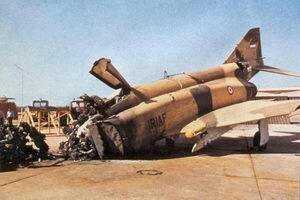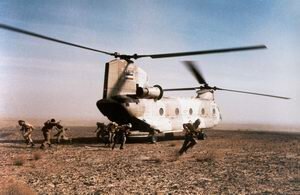|
Airpower is the most difficult of all forms of military force to measure, or even to express in precise terms.
– Winston Churchill
On the afternoon of 22 September 1980, the world was startled when news came of a large surprise Iraqi air attack against seventeen Iranian military bases and civilian installations. These raids signaled the start of the Iraqi invasion of Iran, and a bloody and senseless war; a war which lasted for eight long years, consuming hundreds of thousands of lives, and both countries’ economies and industrial infrastructures. Although the roots of the conflict can, and should be, traced back to the complex political situation of the time, no determined political attempt was made to defuse the very dangerous situation ahead.

Every piece seemed placed perfectly for running and supporting a lengthy war of attrition. An “irresponsible” Islamic revolution had ripped through one of the most important allies of the United States in the region, and even worse, 52 American embassy staff members had been taken hostage by the Iranian extremist anti-West faction to gain an upper hand in the power struggle inside the country. On the other side, there was a ruthless and unpredictable dictator ruling an oil rich Arab country plagued by religious and ethnic diversities. Additionally, the two increasingly unstable neighboring countries had stockpiled large inventories of modern weapons, which were seen as potentially dangerous to the long-lasting Western interests in the Middle East. As Alan Clark, British Minister of State for Defence between 1989-92, acknowledged long after: “The interests of the West were best served by Iran and Iraq fighting each other, and the longer the better.”
Included in this conflict were some of the best-equipped and trained air forces of the so-called Third World. Although the Iraqi and Iranian Air Forces fought very intensively and bitterly in this, the longest conventional warfare of the twentieth century, their operations are still some of the least known and even worst studied ever. Reasons for this historical overlook are manifold: Unlike most other conflicts between 1945 and 1990, this one did not lead to sharp division between the US and Soviet Union (on the other hand, the two superpowers were almost on one side); and it was not a brief and intense encounter like other wars in the Middle East. Furthermore, this long conflict was not only about territory, but also a violent struggle between secular Arab nationalism and the religious ideology of Iran’s new revolutionary Islamic regime. Consequently, it was a principal issue of both sides to convey their politics, rather than military strategy or tactics, and so the vivid and vigorous operations of both fighting air forces went particularly unnoticed or hidden behind a thick curtain of secrecy. Another reason for the lack of information can be traced back to the United States’ dramatic miscalculation regarding the viability, competence, and capability of Iranians to maintain and operate their sophisticated US-supplied weapon systems following the Islamic revolution and withdrawal of the American advisors, for which the U.S. counted on an early return, following the predicted Iranian appeals—something that at least in the known world never materialized. A reluctance to admit such a miscalculation forced the West to ignore, for the most part, the IRIAF’s continuing competence and proficiency in executing its role as an apt and capable fighting force. The Soviet Union officially supported Iraq—more or less for the duration of the whole war with Iran—but this cooperation was always marked by difficult relationships with the self-minded Iraqi leadership. On the other hand, the Soviets used this war as a testing ground for many newly developed weapons, several of which were not particularly successful. The third power, France, was involved foremost in low profile—but massive—arms deliveries to Iraq, most of which occurred as part of a very complicated cooperation between Iraq, France, and India.
Under such circumstances, no “comprehensive” published accounts regarding the air warfare during this conflict have been written so far. Since both authors were highly interested in events during this dramatic, and in many ways unique, they independently embarked on collecting published and unpublished information concerning the Iranian and Iraqi Air Forces, and the corresponding events during the war. Later we worked together for years, being able to discuss the still itching subject with many different—both directly and indirectly—participants. A good part of general information for this book thus came from well established works of reference, official communiqués, and the stories told by journalists who actually were there, but the most important portions and details are from the personal experiences of many Iranian and Iraqi pilots and officers, as well as from different American, Arab, Czech, German, Iranian, Libyan, Polish, Slovak, and Yugoslav sources directly involved. Partially, for the description of the general situation, well-established works of reference, official communiqués, and the stories of journalists were needed. However, as numerous flatly wrong reports were written about this war, or the interpretations were found to be incorrect, we tried to shed a new light on this conflict, from a different overall perspective. This does not mean that all the publications on the subject so far are valueless; far from that. But, we merely found that very few were reliable, and most only hardly scratched the surface. In our opinion, the air warfare between Iraq and Iran—and foremost the capabilities of both air forces involved in it—were completely misunderstood and thus misreported in the West. In most accounts of the First Persian Gulf War, the air war has been overshadowed by the political and religious controversies that surrounded the whole conflict, and in others largely ignored due to the lack of information. In fact, without attempting to judge the political side of this war, the air campaigns over Iran, Iraq, and the Persian Gulf had immense—but unrecognized—military significance and impact.

This significant eight-year-long struggle had been completely different from what was anticipated or assumed, foremost because the operations of both air forces were heavily influenced by the need to score politically interesting results, while at the same time preserving their own might. The reader will certainly notice throughout this work that both politics and strategies, and actual events that happened through the entire conflict, which heavily influenced the conduct of the air war, have been jointly dealt with in unprecedented detail. The authors have tried their best not to overlook any event or tactic, however, a war is a war, and as such there are still many secrets buried behind tall walls. While efforts have been made to dig through these walls, and also to read between the lines through cross-reference, there still remain many secrets that have preferred to remain so. As a result, nobody can claim that such a work will be ultimate and flawless.
While the air war between Iraq and Iran is the prime focus of this work, it also presents a condensed history of military aviation in Iran and Iraq since 1924, and describes how both air arms were structured, reached their zenith, and went forgotten in one of the bloodiest conflicts of the last century. Finally, Iran-Iraq War in the Air 1980-1988 is also an effort to save the memories and experiences of the involved warriors – too many of whom paid the ultimate price in the defense of their country, and who do not deserve to be forgotten.
|

